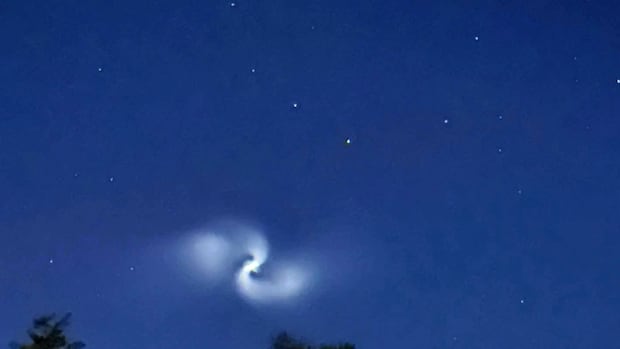New BrunswickA European rocket launch created a glowing spiral in New Brunswick’s evening sky Tuesday, but astronomers identified it as a routine satellite mission.Mysterious spiral Tuesday evening linked to rocket launch from French GuianaJennifer Sweet · CBC News · Posted: Nov 05, 2025 4:46 PM EST | Last Updated: 3 hours agoListen to this articleEstimated 6 minutesC.J. Bernard, an amateur astrophotographer in the Tobique area, captured a swirl-shaped cloud in the western sky at about 7 p.m. Tuesday. (C.J. Bernard)The end of daylight time is coinciding with some interesting sights in the dark evening skies this week.A number of New Brunswickers said they witnessed a swirl-shaped cloud in the western sky at about 7 p.m. Tuesday.Cellphone quality photos were posted from Riverview, Queens County and the northwestern part of the province.C.J. Bernard, an amateur astrophotographer in the Tobique area, happened to be out taking pictures Tuesday night of the “fire-in-the-sky” sunset over the St. John River, or Wolastoq, and of the full moon rising.After he posted some of his shots on Facebook, he noticed the hubbub online over the swirl, turned around and sure enough he could see it right behind him.According to the European Space Agency, a rocket was launched from its spaceport in French Guiana at 7:02 p.m. AT, carrying a satellite for the Sentinel-1 mission, which provides radar vision for the Copernicus Earth observation program.The satellite was placed in orbit 34 minutes later, the agency said in a release posted on its website.Bernard wrote a little blurb about the rocket launch and shared some of his own photos, which have since been seen by hundreds of thousands of people. He chalks it up to being in the right place at the right time. It used to be that rocket launches only happened in the middle of the day, said Bernard, but now they’re taking place around the clock, and in this case, during what photographers refer to as golden hour. Bernard chalks it up to being in the right place at the right time. (Submitted by C.J. Bernard)“When the booster came off, the way the sun was setting, that light was still up there, and it refracted.”What New Brunswickers saw was like a reflection from a bent mirror, he explained. Nancy Colpitts also got a picture of the rocket and posted it in a community group for Wicklow, about 45 kilometres north of Woodstock. “Apparently, the light patterns are fuels burning off as it spirals in orbit,” she wrote.The swirl was visible as it moved northerly across the sky, she said.“The spiral moved in and out of sight as it went though the clouds.”Several other group members replied that they’d also seen it.“You’ve got your conspiracy theorists going like, ‘Oh, let’s UFO.’ It’s this, it’s that,” she said. “It wasn’t Independence Day. I don’t think it was Will Smith coming down with E.T.”WATCH | That picture became kind of a viral trend,’ C.J. Bernard says:What New Brunswickers saw in the sky Tuesday nightMany New Brunswickers saw a bright swirling light in the early evening sky Tuesday. Turns out it was related to the trajectory of a European Space Agency rocket launch in French Guiana. Amateur astrophotographer C.J. Bernard posted a photo and explanation on social media that was shared thousands of times.Bernard has been following weather and astronomy since the ice storm of 1998 in Ottawa. He loves the northern lights and “anything in the sky” and likes to share information about what he sees.He often shares on the Facebook page, New Brunswick Storm and Weather Centre.Tuesday was an exceptional night, he said, with a full moon, a fiery sunset and a rocket in the sky.There’s plenty more to see this month, according to Chris Curwin of Astronomy by the Bay.Members of the Royal Astronomical Society of Canada and the Saint John Astronomy Club are inviting the public to Irving Nature Park on Saturday to skygaze through telescopes and binoculars. Rain dates are Sunday or Monday, he said. “We’re probably the only group that looks forward to the time change,” Curwin said.Curwin said these are some of the sights to behold:Saturn’s “beautiful” ring system, which is visible through a telescope.Jupiter and its four moons, which can be seen even through binoculars.The Andromeda Galaxy.A double cluster of stars in the constellation Perseus.The constellation Orion, which is now rising earlier in the evening.The Orion Nebula, a “stellar nursery,” just below the three stars that make up Orion’s belt.The Pleiades star clusterThe Hyades star clusterThe moonThe Geminid meteor shower, which comes up between Nov. 19 and Dec. 24, peaking on Dec. 13. Aurora sightings, which will be visible Thursday into Friday, the National Oceanic and Atmospheric Administration in the U.S. forecasts.One thing that a lot of stargazers have been buzzing about since July, the comet 3I/ATAS, is not visible unless you have a telescope of at least 10 inches, said Curwin.Even through a telescope, it will appear very faint and smudge-like, he said.The 3I stands for this comet being the third interstellar object that humans have known about. Interstellar means it originated outside our solar system. “There may have been many more, but it’s the third one that we discovered,” said Curwin.The first two were 1I/Oumuamua in 2017 and 2I/Borisovso in 2019.ATLAS is the relatively new survey system by which the comet was spotted. “ATLAS is a global network of four different robotic telescopes in Hawaii, Chile and South Africa, and they’re designed to provide us an early warning of potential asteroid impacts coming to Earth.”“It scans the entire night sky multiple times each night … tracking near-Earth objects and providing us an advance warning in case something’s heading in our direction,” said Curwin.Curwin said 3I/ATLAS is unusual for several reasons. For one thing, it’s not bound to the sun by its gravity.For another, it’s speed of about 60 kilometres a second is high for a comet.And it’s giving off an unusually high amount of carbon dioxide, relative to water, he said.“It could be as old as our solar system, actually billions of years old.”Curwin said 3I/ATLAS is also providing fodder for conspiracy theorists, and the government shutdown in the United States is not helping matters.It’s affecting NASA, which as a result is not releasing much information.“People want more facts. And if they can’t get those facts and, you know, it’s off into, well, what is it really? And what are they not telling us?”But Curwin said he hasn’t seen anything to suggest it’s anything other than a comet. ABOUT THE AUTHORJennifer Sweet has been telling the stories of New Brunswickers for over 20 years. She is originally from Bathurst, got her journalism degree from Carleton University and is based in Fredericton. She can be reached at 451-4176 or jennifer.sweet@cbc.ca. Information Morning Saint John and Shift
Rocket launch creates swirl of light over N.B., sparking curiosity and speculation











